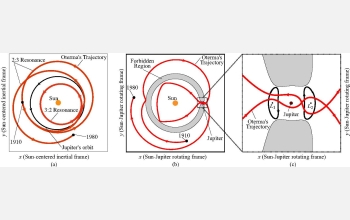All Images
News Release 05-168
Mathematics Unites the Heavens and the Atom
This material is available primarily for archival purposes. Telephone numbers or other contact information may be out of date; please see current contact information at media contacts.

The orbital dynamics of Oterma, a comet that is locked in a long, complex dance with the giant planet Jupiter.
In frame (a) we see a portion of Oterma's orbit from the perspective of the solar system as a whole, using a coordinate system that has the Sun at rest in the center and Jupiter moving in a near-perfect circle once every 12 years. Oterma's intricate path takes it both inside and outside Jupiter's orbit. While it is on the inside it generally stays near a "3:2 resonance," in which Oterma goes three times around the Sun for every two revolutions made by Jupiter. When it is on the outside, likewise, Oterma stays near a near a 2:3 resonance.
In frame (b) we see this same segment of Oterma's orbit from Jupiter's perspective, using a rotating coordinate system that keeps the giant planet stationary. This view makes it clear that Oterma's transition between outside and inside can occur only through a narrow bottleneck around Jupiter. Frame (c) shows a closeup of the bottleneck.
This view also highlights the parallel with atomic physics: an atom moving from one molecule to another often goes through a similar transition.
Credit: Shane D. Ross, University of Southern California
Download the high-resolution JPG version of the image. (116 KB)
Use your mouse to right-click (Mac users may need to Ctrl-click) the link above and choose the option that will save the file or target to your computer.


